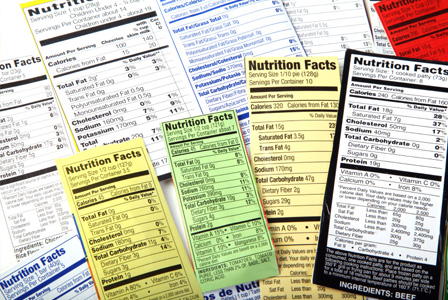KNOWLEDGE
Food Nutrition Label a Puzzle?
July 17, 2014
If you think you’re the only one who gets confused trying to read nutrition labels on food, relax. You’ve got plenty of company.
In a study of educated adults — 75 percent had at least a high school education — most had trouble understanding everyday food nutrition labels. Dietitians aren’t surprised, since they constantly have to explain food labeling to clients. “The biggest problem is (figuring) serving size,” said Dr. Russell Rothman, an assistant professor of internal medicine and pediatrics at the Center for Health Services Research at Vanderbilt University, who led the study about nutrition labels.
His team surveyed 200 primary-care patients from a wide range of socioeconomic backgrounds and asked them to finish a 24-item measure of food label comprehension. They answered, on average, just 69 percent of the questions correctly.
Besides confusing serving sizes, people were most often mixed up about extraneous material on the label, Rothman found. They often calculated the data incorrectly — for instance, only 37 percent could figure the number of carbohydrates consumed from a 20-ounce bottle of soda that contained 2.5 servings. “A soda bottle is typically 20 ounces,” Rothman said, “and it will say, ‘servings per container is 2.5.’ People will not realize that. They think 20 ounces is a serving.” If the label says 200 calories per serving, many will mistakenly think that means the whole bottle. However, after doing the math, the entire bottle would actually provide 500 calories, he said.
“When you are looking at food labels, take your time and be careful,” Rothman advised. “They are confusing and have a lot of complex information in them. Pay particular attention to serving size and how to apply that to how much you are actually eating.” The study was published recently in the American Journal of Preventive Medicine.
Another expert, Susan Moores, a nutrition consultant in Minneapolis and a spokeswoman for the American Dietetic Association, agreed that serving size is where many people get tripped up on reading labels. She said the first few ingredients listed on a label can also give clues to a product’s goodness. “You want to recognize what they are,” Moores said. “If you don’t, that’s a red flag. It means the food is probably not so nutritious.” One exception, she said, might be the label on fortified cereals, where many non-recognizable names could be vitamins and other nutritious ingredients, she said.
Instead of trying to decipher the entire label, consumers can learn a few tricks, Moores and Rothman suggested. For instance, follow the “5 and 20″ rule. “If a label says it contributes 5 percent or less (of the daily value of a particular) nutrient, that is good on some ingredients, such as sodium and cholesterol, fat and sugar,” Moores said. But, she added, it’s not ideal for nutrients you want to increase. If a label says it provides 20 percent of the daily value of a nutrient, likewise, that’s good for nutrients you want to boost — such as vitamins, fiber, calcium or iron — but not for those you want to curtail.
You can look on the packaging itself for specific phrases, such as “low in fat,” Rothman suggested. “These labels are regulated by the Food and Drug Administration,” he said, so consumers have some assurances that the foods are as advertised. That’s not foolproof, however. “Some foods low in calories may not be better (than other foods) in other nutritional ingredients. They may have too much salt or fat,” Rothman said.
If you still have trouble with label reading, Rothman offered up two more ways to be sure you focus on nutritious foods. First, you can follow an eating plan, such as Weight Watchers, he said, which advises you to eat five servings or more of fruits and vegetables, two to three servings of low-fat or non-fat dairy products daily, and to limit your calories. “If you still find it very hard, when you meet with your physician or a registered dietitian, ask for help from them,” he said. “Ask them to suggest something else practical you can do.”
Gold's Gym Club
Gold's Gym Mall Ciputra | Gold's Gym Mall of Indonesia | Gold's Gym Thamrin City | Gold's Gym Cilandak Town Square | Gold's Gym Baywalk Mall Pluit | Gold's Gym Kalibata City Mall | Gold's Gym Braga Citywalk | Gold's Gym Cihampelas Walk | Gold's Gym Summarecon Mall Serpong | Gold's Gym Mall @ Alam Sutera | Gold's Gym Bintaro X-change | Gold's Gym The Breeze BSD | Gold's Gym Grand City Surabaya | Gold's Gym Surabaya Town Square | Gold's Gym Grand Metropolitan Bekasi
Gold's Gym Mall Ciputra | Gold's Gym Mall of Indonesia | Gold's Gym Thamrin City | Gold's Gym Cilandak Town Square | Gold's Gym Baywalk Mall Pluit | Gold's Gym Kalibata City Mall | Gold's Gym Braga Citywalk | Gold's Gym Cihampelas Walk | Gold's Gym Summarecon Mall Serpong | Gold's Gym Mall @ Alam Sutera | Gold's Gym Bintaro X-change | Gold's Gym The Breeze BSD | Gold's Gym Grand City Surabaya | Gold's Gym Surabaya Town Square | Gold's Gym Grand Metropolitan Bekasi
CONTENT WRITE UNDER





